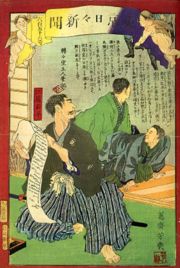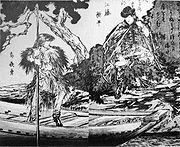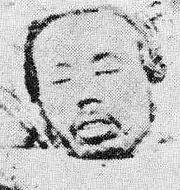
Saga Rebellion
Encyclopedia
The was an 1874 uprisings in Kyūshū
against the new Meiji government of Japan
. It was led by Etō Shimpei
and Shima Yoshitake
in their native domain of Hizen
.
, many members of the former samurai class were disgruntled with the direction the nation had taken. The abolition of their former privileged social status under the feudal order had also eliminated their income, and the establishment of universal military conscription had eliminated much of their reason for existence. The very rapid modernization (Westernization) of the country was resulting in massive changes to Japanese culture, language, dress and society, and appeared to many samurai to be a betrayal of the jōi (“Expel the Barbarian”) portion of the Sonnō jōi
justification used to overthrow the former Tokugawa shogunate
.
Hizen Province
, with a large samurai population, was a center of unrest against the new government. Older samurai formed political groups rejecting both overseas expansionism and westernization, and calling for a return to the old feudal order. Younger samurai organized the group Seikantō political party
, advocating militarism
and the invasion of Korea
.
, former Justice Minister
and sangi (Councilor) in the early Meiji government resigned his posts in 1873 to protest the government's refusal to launch a military expedition against Korea
(Seikanron
). Eto then assisted Itagaki Taisuke
in organizing the Aikoku Kōtō
political party, and in composing the Tosa Memorial, a sharp criticism of the government. In January 1874, frustrated by the government's rejection of his efforts, he returned to his native Saga
where both the traditionists and the Seikantō samurai rallied to his support.
Alarmed by growing rumors of unrest, Home Minister
Ōkubo Toshimichi
dispatched his henchman Iwamura Takatoshi to Saga to restore order. Iwamura only made the situation worse with his overbearing attitude. On the ship to Saga, he made an enemy of Shima Yoshitake, the former governor of Akita Prefecture
, who was traveling to Saga at the request of Sanjō Sanetomi
. Iwamura so outraged Shima that Shima decided to throw his lot in with Etō and his rebels.
 Etō decided to take action on 1874-02-16 by raiding a bank and occupying government offices with the grounds of old Saga castle. Etō had expected that similarly disaffected samurai in Satsuma
Etō decided to take action on 1874-02-16 by raiding a bank and occupying government offices with the grounds of old Saga castle. Etō had expected that similarly disaffected samurai in Satsuma
and Tosa
would stage insurrections when they received word of his actions, but he had miscalculated badly, and both domains remained calm.
On February 19, Ōkubo set up his headquarters in Hakata
and issued a proclamation condemning the Saga rebels as traitors. Government troops marched into Saga the following day. After losing a battle on the border of Saga and Fukuoka
on February 22, Eto decided that further resistance would only result in needless deaths, and disbanded his army.
Etō told his followers that he intended to escape to Kagoshima to obtain help from Saigō Takamori
and his Satsuma samurai. If Saigō refused, he intended to go to Tosa, and if Tosa likewise refused, he would make his way to Tokyo
to commit seppuku
.
 Although the Saga rebels were greatly demoralized by Etō's flight, they continued to fight on, with some of the most violent combat occurring in the streets of Saga on February 27. Shima, who announced his decision to die fighting at Saga castle, fled that night for Kagoshima with his staff. Government forces seized Saga Castle of March 1 without further bloodshed.
Although the Saga rebels were greatly demoralized by Etō's flight, they continued to fight on, with some of the most violent combat occurring in the streets of Saga on February 27. Shima, who announced his decision to die fighting at Saga castle, fled that night for Kagoshima with his staff. Government forces seized Saga Castle of March 1 without further bloodshed.
Arrest warrants were circulated for Etō and Shima, and it is ironic that Etō was on the run as a fugitive from the very police force whom he had helped create. Etō was refused support in Kagoshima, and fled to Tosa in a fishing boat, where he was received coldly. While attempting to find a boat to take him to Tokyo, he was apprehended on March 28.
 Sympathy for Etō was high, with Sanjo Sanetomi writing to Ōkubo to remind him that Etō's motives were not evil, and with Kido Takayoshi
Sympathy for Etō was high, with Sanjo Sanetomi writing to Ōkubo to remind him that Etō's motives were not evil, and with Kido Takayoshi
likewise writing to suggest that Etō be employed in the upcoming Taiwan Expedition of 1874
. However, Okubo was adamant that an example be set, and Etō and Shima were tried by a military tribunal
on 1874-04-08 and executed the next day along with eleven other leaders of the revolt. Etō was beheaded at Ōkubo's orders, and his severed head placed on public display – considered a demeaning punishment for someone of samurai class. Photographs were taken and were sold in Tokyo; however, the Tokyo government later banned their sale and ordered people who purchased the photographs to return them. Ōkubo, however, refused to comply and hung a copy of the photograph in the reception room of the Home Ministry.
.
Kyushu
is the third largest island of Japan and most southwesterly of its four main islands. Its alternate ancient names include , , and . The historical regional name is referred to Kyushu and its surrounding islands....
against the new Meiji government of Japan
Japan
Japan is an island nation in East Asia. Located in the Pacific Ocean, it lies to the east of the Sea of Japan, China, North Korea, South Korea and Russia, stretching from the Sea of Okhotsk in the north to the East China Sea and Taiwan in the south...
. It was led by Etō Shimpei
Eto Shimpei
, was a Japanese statesman during the early Meiji period, remembered chiefly for his role in the unsuccessful Saga Rebellion.- Early Life & Meiji Bureaucrat :...
and Shima Yoshitake
Shima Yoshitake
was a samurai from Saga domain. He later became a chamberlain and later a governor for Akita Prefecture.-External links:*...
in their native domain of Hizen
Hizen Province
was an old province of Japan in the area of Saga and Nagasaki prefectures. It was sometimes called , with Higo Province. Hizen bordered on the provinces of Chikuzen and Chikugo. The province was included in Saikaidō...
.
Background
Following the 1868 Meiji RestorationMeiji Restoration
The , also known as the Meiji Ishin, Revolution, Reform or Renewal, was a chain of events that restored imperial rule to Japan in 1868...
, many members of the former samurai class were disgruntled with the direction the nation had taken. The abolition of their former privileged social status under the feudal order had also eliminated their income, and the establishment of universal military conscription had eliminated much of their reason for existence. The very rapid modernization (Westernization) of the country was resulting in massive changes to Japanese culture, language, dress and society, and appeared to many samurai to be a betrayal of the jōi (“Expel the Barbarian”) portion of the Sonnō jōi
Sonno joi
is a Japanese political philosophy and a social movement derived from Neo-Confucianism; it became a political slogan in the 1850s and 1860s in the movement to overthrow the Tokugawa bakufu, during the Bakumatsu period.-Origin:...
justification used to overthrow the former Tokugawa shogunate
Tokugawa shogunate
The Tokugawa shogunate, also known as the and the , was a feudal regime of Japan established by Tokugawa Ieyasu and ruled by the shoguns of the Tokugawa family. This period is known as the Edo period and gets its name from the capital city, Edo, which is now called Tokyo, after the name was...
.
Hizen Province
Hizen Province
was an old province of Japan in the area of Saga and Nagasaki prefectures. It was sometimes called , with Higo Province. Hizen bordered on the provinces of Chikuzen and Chikugo. The province was included in Saikaidō...
, with a large samurai population, was a center of unrest against the new government. Older samurai formed political groups rejecting both overseas expansionism and westernization, and calling for a return to the old feudal order. Younger samurai organized the group Seikantō political party
Political party
A political party is a political organization that typically seeks to influence government policy, usually by nominating their own candidates and trying to seat them in political office. Parties participate in electoral campaigns, educational outreach or protest actions...
, advocating militarism
Japanese militarism
refers to the ideology in the Empire of Japan that militarism should dominate the political and social life of the nation, and that the strength of the military is equal to the strength of a nation.-Rise of militarism :...
and the invasion of Korea
Korea
Korea ) is an East Asian geographic region that is currently divided into two separate sovereign states — North Korea and South Korea. Located on the Korean Peninsula, Korea is bordered by the People's Republic of China to the northwest, Russia to the northeast, and is separated from Japan to the...
.
Prelude
Etō ShimpeiEto Shimpei
, was a Japanese statesman during the early Meiji period, remembered chiefly for his role in the unsuccessful Saga Rebellion.- Early Life & Meiji Bureaucrat :...
, former Justice Minister
Minister of Justice (Japan)
The is the member of the Cabinet of Japan in charge of the Ministry of Justice. The post has been held by Hideo Hiraoka since 2 September 2011.- Ministers of Justice :...
and sangi (Councilor) in the early Meiji government resigned his posts in 1873 to protest the government's refusal to launch a military expedition against Korea
Korea
Korea ) is an East Asian geographic region that is currently divided into two separate sovereign states — North Korea and South Korea. Located on the Korean Peninsula, Korea is bordered by the People's Republic of China to the northwest, Russia to the northeast, and is separated from Japan to the...
(Seikanron
Seikanron
The Seikanron debate was a major political conflagration which occurred in Japan in 1873....
). Eto then assisted Itagaki Taisuke
Itagaki Taisuke
Count was a Japanese politician and leader of the , which evolved into Japan's first political party.- Early life :Itagaki Taisuke was born into a middle-ranking samurai family in Tosa Domain, , After studies in Kōchi and in Edo, he was appointed as sobayonin to Tosa daimyo Yamauchi Toyoshige,...
in organizing the Aikoku Kōtō
Aikoku Koto
The ' was a political party in Meiji period Japan.The Aikoku Kōtō was formed in January 1874 by Itagaki Taisuke, Etō Shimpei, Gotō Shōjirō and others as part of the Freedom and People's Rights Movement. Its purpose was to petition the Meiji government to establish a national assembly...
political party, and in composing the Tosa Memorial, a sharp criticism of the government. In January 1874, frustrated by the government's rejection of his efforts, he returned to his native Saga
Saga, Saga
is the capital of Saga Prefecture, located on the island of Kyūshū, Japan.Saga was the capital of Saga Domain in the Edo period, and largest city of former Hizen Province....
where both the traditionists and the Seikantō samurai rallied to his support.
Alarmed by growing rumors of unrest, Home Minister
Home Ministry (Japan)
The ' was a Cabinet-level ministry established under the Meiji Constitution that managed the internal affairs of Empire of Japan from 1873-1947...
Ōkubo Toshimichi
Okubo Toshimichi
, was a Japanese statesman, a samurai of Satsuma, and one of the three great nobles who led the Meiji Restoration. He is regarded as one of the main founders of modern Japan.-Early life:...
dispatched his henchman Iwamura Takatoshi to Saga to restore order. Iwamura only made the situation worse with his overbearing attitude. On the ship to Saga, he made an enemy of Shima Yoshitake, the former governor of Akita Prefecture
Akita Prefecture
is a prefecture of Japan located in the Tōhoku Region of northern Honshu, the main island of Japan. The capital is the city of Akita.- History :The area of Akita has been created from the ancient provinces of Dewa and Mutsu....
, who was traveling to Saga at the request of Sanjō Sanetomi
Sanjo Sanetomi
Prince was an Imperial court noble and statesman at the time of the Meiji Restoration. He held many high-ranking offices in the Meiji government.-Biography:Born in Kyoto, Sanjō was the son of Naidaijin Sanjō Sanetsumu...
. Iwamura so outraged Shima that Shima decided to throw his lot in with Etō and his rebels.
The Rebellion

Satsuma han
The Satsuma domain was one of the most powerful feudal domains in Tokugawa Japan, and played a major role in the Meiji Restoration and in the government of the Meiji period which followed...
and Tosa
Tosa Domain
The was a feudal domain in Tosa Province of Japan during the Edo period. Its official name is . Some from the domain played important roles in events in the late Tokugawa shogunate...
would stage insurrections when they received word of his actions, but he had miscalculated badly, and both domains remained calm.
On February 19, Ōkubo set up his headquarters in Hakata
Hakata-ku, Fukuoka
is one of the seven wards of Fukuoka City, Fukuoka Prefecture, Japan. It is best known as the location of Fukuoka's main train station, Hakata Station.-Geography:...
and issued a proclamation condemning the Saga rebels as traitors. Government troops marched into Saga the following day. After losing a battle on the border of Saga and Fukuoka
Fukuoka Prefecture
is a prefecture of Japan located on Kyūshū Island. The capital is the city of Fukuoka.- History :Fukuoka Prefecture includes the former provinces of Chikugo, Chikuzen, and Buzen....
on February 22, Eto decided that further resistance would only result in needless deaths, and disbanded his army.
Etō told his followers that he intended to escape to Kagoshima to obtain help from Saigō Takamori
Saigo Takamori
was one of the most influential samurai in Japanese history, living during the late Edo Period and early Meiji Era. He has been dubbed the last true samurai.-Early life:...
and his Satsuma samurai. If Saigō refused, he intended to go to Tosa, and if Tosa likewise refused, he would make his way to Tokyo
Tokyo
, ; officially , is one of the 47 prefectures of Japan. Tokyo is the capital of Japan, the center of the Greater Tokyo Area, and the largest metropolitan area of Japan. It is the seat of the Japanese government and the Imperial Palace, and the home of the Japanese Imperial Family...
to commit seppuku
Seppuku
is a form of Japanese ritual suicide by disembowelment. Seppuku was originally reserved only for samurai. Part of the samurai bushido honor code, seppuku was either used voluntarily by samurai to die with honor rather than fall into the hands of their enemies , or as a form of capital punishment...
.

Arrest warrants were circulated for Etō and Shima, and it is ironic that Etō was on the run as a fugitive from the very police force whom he had helped create. Etō was refused support in Kagoshima, and fled to Tosa in a fishing boat, where he was received coldly. While attempting to find a boat to take him to Tokyo, he was apprehended on March 28.

Kido Takayoshi
, also referred as Kido Kōin was a Japanese statesman during the Late Tokugawa shogunate and the Meiji Restoration. He used the alias when he worked against the Shogun.-Early life:...
likewise writing to suggest that Etō be employed in the upcoming Taiwan Expedition of 1874
Taiwan Expedition of 1874
The , usually referred to in Taiwan and mainland China as the Mudan incident , was a punitive expedition launched by the Japanese in retaliation for the murder of 54 Ryukyuan sailors by Paiwan aborigines near the southwestern tip of Taiwan in December 1871...
. However, Okubo was adamant that an example be set, and Etō and Shima were tried by a military tribunal
Military tribunal
A military tribunal is a kind of military court designed to try members of enemy forces during wartime, operating outside the scope of conventional criminal and civil proceedings. The judges are military officers and fulfill the role of jurors...
on 1874-04-08 and executed the next day along with eleven other leaders of the revolt. Etō was beheaded at Ōkubo's orders, and his severed head placed on public display – considered a demeaning punishment for someone of samurai class. Photographs were taken and were sold in Tokyo; however, the Tokyo government later banned their sale and ordered people who purchased the photographs to return them. Ōkubo, however, refused to comply and hung a copy of the photograph in the reception room of the Home Ministry.
Consequences
Although the samurai uprising in Saga had been suppressed by military force, the issues which led to the uprising remained unresolved. Kyūshū continued to be a hotbed of unrest against the central government through the 1870s, culminating with the Satsuma RebellionSatsuma Rebellion
The was a revolt of Satsuma ex-samurai against the Meiji government from January 29 to September 24, 1877, 9 years into the Meiji Era. It was the last, and the most serious, of a series of armed uprisings against the new government.-Background:...
.
See also
- Hagi RebellionHagi RebellionThe 1876 was one of a number of ex-samurai uprisings which took place in the early Meiji period against the new Meiji government of Japan-Background:...
- Akizuki RebellionAkizuki Rebellion-See also:*Hagi Rebellion*Saga Rebellion*Shinpūren Rebellion*Satsuma Rebellion...
- Shimpūren Rebellion
- Satsuma RebellionSatsuma RebellionThe was a revolt of Satsuma ex-samurai against the Meiji government from January 29 to September 24, 1877, 9 years into the Meiji Era. It was the last, and the most serious, of a series of armed uprisings against the new government.-Background:...

